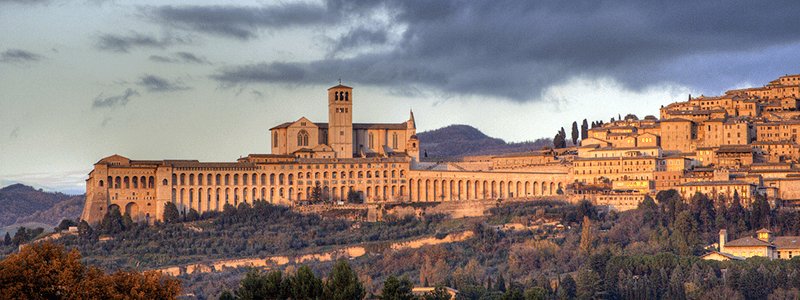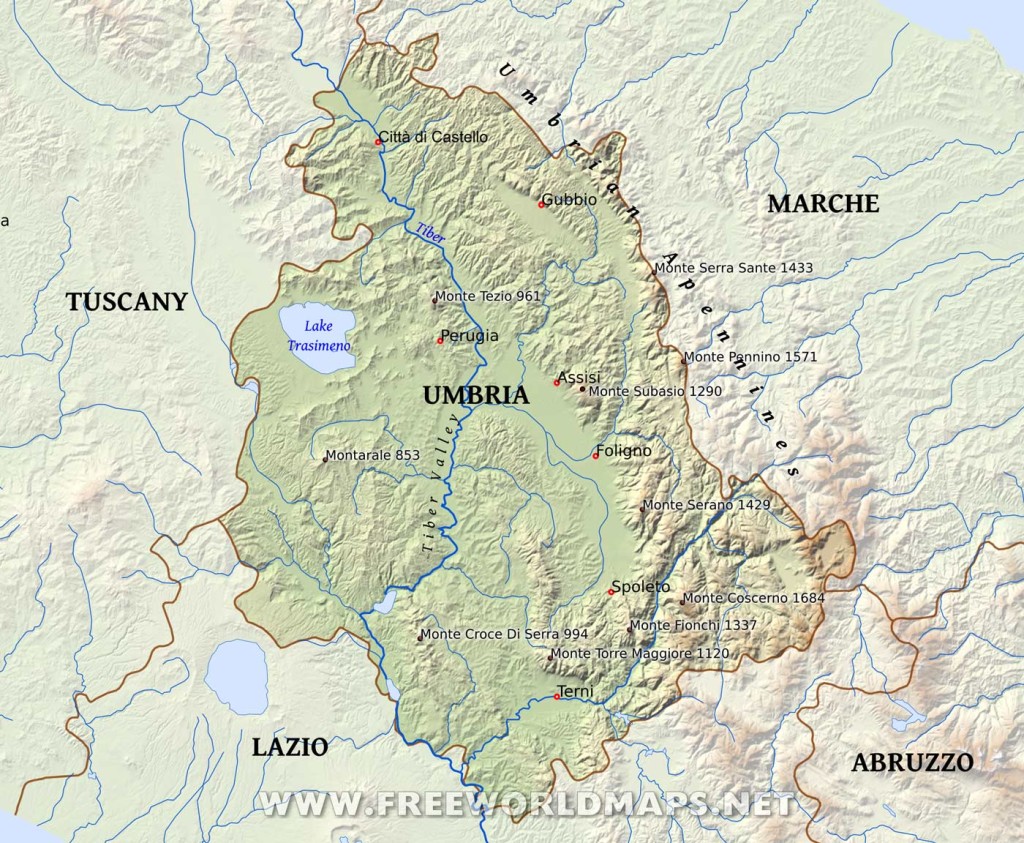
Often overshadowed by its famous neighbor Tuscany, the Region of Umbria is a hidden gem, offering picturesque medieval towns, lush landscapes, and an authentic Italian experience without the crowds. Known as “Italy’s green heart,” Umbria is a land of rolling hills, deep valleys, and breathtaking mountain ranges.
With a history shaped by the Umbri, Etruscans, Romans, and medieval city-states, Umbria is home to some of Italy’s most well-preserved historic towns, magnificent cathedrals, and artistic masterpieces. Whether you’re seeking spiritual retreats, outdoor adventures, or rich culinary traditions, Umbria offers something for every traveler.
A Unique History: The Land of Saints and City-States
The Ancient Umbri and Etruscans
Umbria takes its name from the Umbri people, one of Italy’s earliest tribes, mentioned by Pliny the Elder as the oldest civilization in the region. However, the Etruscans, expanding from Tuscany, controlled key cities like Perugia and Orvieto, pushing the Umbri eastward into the hills.
Roman and Medieval Legacies
- Roman Influence – Umbria became an important Roman province, and cities like Spoleto and Bevagna still showcase impressive Roman ruins.
- Medieval Hilltown Rivalries – After the fall of Rome, independent city-states fought for dominance, creating a landscape of fortified towns and castles.
- Papal Rule & Religious Identity – The region fell under the Papal States, developing a deep spiritual heritage, earning the nickname “La Terra dei Santi” (Land of Saints).
Umbria’s Renaissance and Cultural Revival
The Renaissance left a profound mark on Umbria, with artistic masterpieces by Giotto, Perugino, and Pinturicchio decorating the region’s churches and palaces. Today, Umbria is a thriving cultural center, hosting international festivals and attracting artists, musicians, and travelers from around the world.
Top Cities and Towns to Visit in Umbria
Perugia – The Historic and Cultural Capital of Umbria
Perugia, the region’s capital, is a vibrant university town with rich history, Renaissance art, and a lively atmosphere.
Must-See Attractions:
- Piazza IV Novembre & Fontana Maggiore – The heart of Perugia, with a beautiful medieval fountain.
- Rocca Paolina – A massive underground fortress, built by the Papal States.
- Galleria Nazionale dell’Umbria – Home to masterpieces by Perugino and Pinturicchio.
- Eurochocolate Festival (October) – One of Europe’s biggest chocolate festivals.
Assisi – The Spiritual Heart of Italy
Assisi, the birthplace of Saint Francis, is one of the most sacred sites in Italy.
Top Attractions:
- Basilica di San Francesco – A UNESCO-listed pilgrimage site, featuring frescoes by Giotto.
- Rocca Maggiore – A medieval fortress with breathtaking views.
- Santa Maria degli Angeli – Home to the Porziuncola, the tiny chapel where St. Francis prayed.
Orvieto – A Hilltop City of Mysteries and Wine
Orvieto is perched on a dramatic tuff cliff, with Etruscan tunnels, medieval streets, and fine wines.
Highlights:
- Orvieto Cathedral – One of Italy’s greatest Gothic cathedrals, featuring Luca Signorelli’s frescoes.
- St. Patrick’s Well – A deep, spiral staircase well, built for medieval water supply.
- Orvieto Classico Wine – Sample Umbria’s famous white wine.
Spoleto – A Town of Roman and Medieval Marvels
Spoleto blends Roman ruins, medieval churches, and Renaissance charm.
Must-Visit Sites:
- Ponte delle Torri – A massive medieval aqueduct with stunning views.
- Roman Amphitheater – An ancient theater still used for performances.
- Festival dei Due Mondi (June-July) – One of Italy’s top cultural festivals, featuring music, theater, and dance.
Gubbio – The Most Perfect Medieval Town
Gubbio is a beautifully preserved medieval town, known for its historic center and ancient traditions.
Best Attractions:
- Palazzo dei Consoli – A majestic medieval palace overlooking the town.
- Gubbio’s Roman Theater – One of Italy’s oldest surviving theaters.
- Festa dei Ceri (May 15th) – A wild race carrying giant wooden candles through the streets.
Umbria’s Natural Beauty: Parks, Lakes, and Mountains
Lago Trasimeno – The Largest Lake in Central Italy
Lago Trasimeno offers serene landscapes, charming lakeside villages, and outdoor activities.
Things to Do:
- Boat trips to Isola Maggiore – Explore a medieval fishing village.
- Watersports & Hiking – Enjoy kayaking, sailing, and scenic trails.
Monti Sibillini National Park – A Land of Legends and Peaks
A paradise for hikers, cyclists, and nature lovers, the Monti Sibillini range is one of Italy’s best-kept secrets.
Top Experiences:
- Piano Grande – A vast plateau, famous for its springtime wildflower bloom.
- Hiking the Valnerina – Explore rugged gorges, waterfalls, and medieval villages.
Cascata delle Marmore – Italy’s Most Spectacular Waterfall
Cascata delle Marmore is a man-made waterfall created by the Romans, plunging 165 meters into the valley.
Outdoor Activities: Adventure in Umbria
Hiking & Trekking
- Monte Subasio – Offers panoramic views of Assisi and the Umbrian countryside.
- Sentiero degli Ulivi (Olive Trail) – A scenic hiking route through olive groves and medieval villages.
Cycling & Horseback Riding
- The Greenway del Nera – A bike path through forests, rivers, and waterfalls.
- Horseback riding in the Umbrian hills – Perfect for exploring rural landscapes.
Umbria’s Food & Wine: A Rustic Culinary Experience
Must-Try Dishes in Umbria
- Torta al Testo – A traditional Umbrian flatbread, often served with cured meats.
- Strangozzi al Tartufo – Handmade pasta with black truffles.
- Porchetta – Slow-roasted pork, seasoned with wild herbs.
- Lenticchie di Castelluccio – Small, flavorful lentils from the Sibillini Mountains.
Umbria’s Best Wines
- Sagrantino di Montefalco – A bold red wine, unique to Umbria.
- Orvieto Classico – A crisp white wine, perfect for warm summer days.
Getting Around Umbria
Public Transport
- Trains – Connect major cities like Perugia, Assisi, and Orvieto.
- Buses – Serve rural towns and nature areas, but are less frequent.
Best Way to Explore?
A rental car is recommended for exploring remote villages, scenic landscapes, and hidden gems.
Why Visit the Region of Umbria?
Umbria is Italy’s best-kept secret, offering:
✅ Stunning medieval hilltowns
✅ Breathtaking natural landscapes
✅ Rich artistic and religious heritage
✅ Incredible food and wine traditions
Whether you’re wandering through Assisi, hiking the Sibillini Mountains, or savoring Umbrian truffles, this region promises a truly unforgettable experience.














